What is Field Marketing and Why Does It Matter?
Learn what field marketing is and how it aligns with marketing objectives to drive sales for a company.
What is Field Marketing?
Field Marketing is a series of activities carried out by highly trained marketers that contribute to the brand building, customer relationship management, lead generation efforts of a client/company. Field marketing includes targeted direct sales promotions, merchandising, auditing, sampling, demonstration, experiential marketing, organizing roadshows, and events.
The Field Marketing Council defines field marketing as 'measurable, face-to-face brand development and customer relationship management through using highly trained people.'
Field marketers are responsible for interacting with the brand's customer/prospect base to inform, educate, influence, and persuade them towards a purchase decision.
In the B2B context, field marketers have a mixture of sales and marketing expertise and engage with customers/prospects across several touchpoints such as events, trade shows, conferences, webinars, and in-person meetings.
In the B2C context, field marketers are present at locations where there is a high density of prospects - at shopping malls, street corners, eating joints, gyms, marathons, etc.
Benefits Of Field Marketing
Field marketers are highly trained to match the needs of the target audience and are fully aware of their business and brand values.
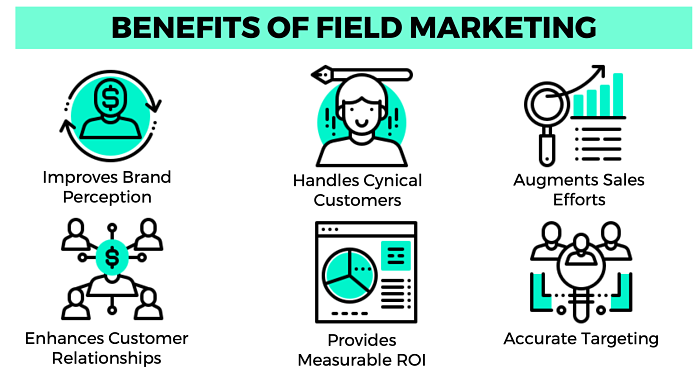
Here are the most significant field marketing benefits that every company could experience:
Improves Brand Perception
Field marketing enables brands to interact directly with their target audience and allows them to experience the brand first-hand.
Field marketing is often at the point of sale or during specific events (such as exhibitions, conferences, roadshows, webinars, etc.).
These are ideal points to gain mindshare of the prospect, instill brand values, and increase brand loyalty until they become customers.
Field marketing is the process of registering your offer in the minds of customers to remind them of your product's existence and availability when they have a need.
In today’s marketing mix, brands also extend these personalized experiences through digital and mobile channels to stay top of mind beyond in-person interactions. G2’s guide on mobile marketing software highlights how the right tools can help marketers connect with audiences seamlessly across both physical and digital touchpoints.
Handles Cynical Customers
Customer cynicism is real. Customers are intelligent, savvy, and better-informed. They are looking for instant gratification rather than drawn-out negotiations, as they try to get answers to their questions.
Field marketing is best suited to deal with cynical customers because field marketers can answer real-time during product demonstrations, onboarding, events, webinars, POS interactions.
Augments the Sales Effort
Sales reps have their hands full by attending to qualified leads that the marketing teams get into the sales funnel. Often, they may not have enough bandwidth to onboard customers or nurture them as they gradually become familiar with a product/service.
Field marketers can take the lead here to take the pressure off sales teams and handhold prospects until they are comfortable on their own.
Enhances Customer Relationships
Field marketing helps provide a consistent customer experience wherever and whenever the customer touches the brand.
Once customers have purchased a product or availed a service, they expect to be identified and recognized - this is table stakes in today's fast-paced world.
For example, once a customer has been to a retail store, he or she expects the retailer to know everything about himself or herself in the next interaction.
Field marketing reps can provide customers with consistent answers for all their queries, thereby increasing their trust in the organization.
Provides Measurable ROI
Successful field marketing campaigns give quantifiable and tangible results. Brands get real-time reporting through the use of field marketing reporting software that loads onto a multitude of devices like mobile phones, tablets, and laptops.
Product managers and brand owners can view reports on a real-time basis through tablets, mobiles, websites, dashboards, and learn how their field marketing campaigns are performing.
Accurate Targeting
Field marketing activities include sales promotions, onboarding, nurturing, sampling, demonstration, experiential marketing, organizing events, roadshows, and conferences.
Field marketers responsible for these activities, choose the locations, formats, in-house (and external) experts, and marketing collateral after researching about their target audience. This approach helps them cater to the needs of the target audience in a focused manner.
Explaining Field Marketing Activities
Field marketing activities include five major disciplines that we have explained below:
Sales
Highly trained sales staff find, understand, and hold dialogue with the target audience intending to sell. This field marketing activity is usually carried out at events with a high footfall of the brand's target market. Brands often outsource this activity to field marketing agencies so that they can concentrate on their core business.
Merchandising
Merchandising is the positioning of marketing material (such as posters, shelf barkers) in a retail environment.
Merchandising in field marketing also encompasses:
- Developing a relationship and rapport with the retailer.
- Ensuring that products are well stocked, captivatingly displayed, and vigorously promoted.
- Measuring and evaluating the performance of the brand within the retail outlet.

Auditing
Auditing is the recording of information about the position of a brand in the marketplace. A field marketing audit reports how a brand and its competitors are distributed among stores and within them. It also measures how the products are displayed by mapping product stock levels, facings, and order sizes.
Auditing helps formulate a strategy for other marketing and field marketing activities. With real-time reporting tools, the audit process has become swift and less tedious.
Sampling and Demonstrating
During this FM exercise, a field marketer demonstrates the working of a product to the customer or allows the customer to try/taste a product.
This activity is most effective when a targeted customer chosen for sampling and demonstration has the capability of being a brand ambassador.
These brand ambassadors are usually people who can influence more sales by showing the brand in a positive light and discussing it within their social circle.
Experiential Marketing, Events and roadshows:
DMA defines Experiential Marketing as: 'A live and interactive marketing discipline, which builds positive emotional, sensory engagement between a brand and its consumers.'
Although every field marketing activity helps the customer to experience a brand, this specific activity is synonymous with exciting, engaging, and entertaining.
Field marketing using events and roadshows induce an emotional relationship between the customer and a brand.
These field marketing activities, individually or combined, develop brands and in their implementation, show a real ROI to the company.
Field marketing activities are in alignment with marketing objectives that will be achieved by their implementation. They help create attention on a product/solution/brand, at a specific time, when customer awareness and experience of a brand can be influenced.

Field Marketing vs. Digital Marketing
Field marketing and digital marketing are different disciplines.
Digital Marketing is about reaching customers via digital media over digital platforms using digital devices.
Sounds complicated? Let us break it down.
- Digital Media - Digital media includes email, messaging, apps, internet, and intranet.
- Digital Platforms - Platforms such as Facebook, Twitter, Instagram, and LinkedIn are different digital platforms.
- Digital Devices - Mobiles, tablets, laptops, desktops, television, and gaming devices.
Let us now look into the difference between Field Marketing and Digital Marketing:
|
|
Field Marketing |
Digital Marketing |
|
Definition |
A series of activities that contribute to the brand building, customer relationship management, lead generation efforts of a client/company. |
Digital Marketing is about reaching customers via digital media over digital platforms using digital devices. |
|
Point of Communication |
Field marketing takes place at Point-of-Sale, during events, conferences, exhibitions, etc. |
Digital marketing is through digital media such as ads, blogs, websites, and promotions. |
|
Mode of Communication |
Field marketing is done face-to-face with customers such as freebies, handouts, etc. |
Occurs using digital means such as internet, television, etc. |
|
Audience Reach |
Limited reach. |
Wider reach with the targeted audience. |
|
Applicability |
Retail, convenience & department stores, IT companies. |
Applicable to all kinds of industries and businesses. |
|
Personnel Training |
Field marketing requires staff training. |
Digital marketing needs specialized skills such as SEO, content marketing, etc. |
|
Cost |
Expensive. |
Not expensive, executable using the internet and a device. |
|
Results |
Can take time – days, weeks, or even months to take effect. |
Real-time, such as clicks, signups, purchases, and conversions. |
|
Viral |
Limited to the target audience at point-of-contact. |
Videos, pictures, tweets, etc. can be instantly viral. |
Best Field Marketing Event Ideas
In this section, let us look into a few field B2B marketing event ideas that you can use at your organization:
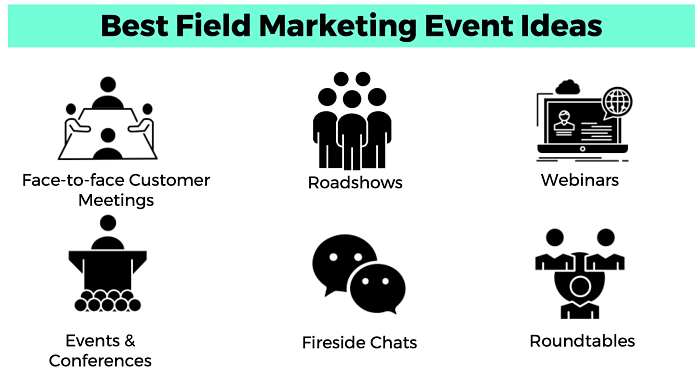
Face-to-face Customer Meetings
Field marketers can work with the sales and customer support teams to set up in-person meetings to guide customers through their buyer's journey or understand their challenges. They have the requisite knowledge, skills, and understanding and are best positioned to step in here to handhold customers.
Tradeshow marketing:
Measuring these field marketing metrics gives you a complete picture of campaign performance. You’ll understand not just how many showed up or converted, but how qualified the leads were, what pipeline they influenced, and how efficiently your budget was spent.
It also uncovers brand impact, buyer intent, and areas for improvement—helping you refine strategy and prove ROI with confidence.
Roadshows
Roadshows are splendid opportunities for lead generation and brand promotion. Field marketers can use branded marketing collateral and props/standees to host a booth and help prospects learn about their offerings.
Interested passersby get to sample the product and provide immediate feedback. Roadshows can last anywhere from a couple of hours to an entire day.
Webinars
Field marketers can participate in webinars to demonstrate how a product works. Experts (such as product managers, analysts, customers) can be invited to weigh in with their thoughts. Specific features of a product can be explained to ensure leads or prospects know how to use it independently.
Webinars enable field marketers to reach out to a niche target audience that has a strong buyer intent and answer their queries directly, so that decision making is easy.
Events & Conferences
Events and conferences are a field marketer's favorite hangout. They provide natural opportunities to network with potential leads/prospects and understand what their challenges are. Customers/prospects can be engaged on the sidelines of a conference, and a quick demo helps them acclimatize with a brand or a product or a service.
Fireside Chats
Fireside chats originated during President Franklin D Roosevelt's time when he addressed American citizens on a series of national topics over the radio.
They are short sessions featuring subject matter experts such as economists, researchers, scientists, CXOs, thought leaders who hold sway over a broad audience. Field marketers can either quiz them directly or invite an expert to interview them.
Roundtables
Roundtable discussions involve a select group of eminent personalities discussing a chosen topic hosted by an expert. These forums feature a niche target audience ranging about 30-50 members.
Roundtable discussions feature pre-decided topics enabling panel members to prepare for them and answer audience queries.
These field marketing event ideas can help teams ponder over the best ones that fit their budgets, objectives, and marketing strategy. Field marketers can plan and execute their campaigns that are most suited to their business, products, and the target audience's tastes.
However, what is important is to capture lead information from these events and nurture them meticulously with marketing collateral until they become customers.
lunch & learns
These are casual, in-person sessions where field marketers educate prospects or partners over lunch. They're low-pressure, relationship-driven, and ideal for B2B outreach.
- Venue: Prospect’s office, coworking space, or nearby café
- Format: 15–20 min presentation + Q&A
- Audience: Busy decision-makers or regional teams
- Content: Product overview, use cases, value props
- Follow-up: Sales outreach + digital recap
They're cost-effective, easy to scale regionally, and help spark informed, qualified conversations without the hard sell.
Uncovering the Most Successful Field Marketing Campaigns
In this section, we have handpicked the most successful field marketing campaigns that have helped companies to generate interest and curiosity amongst the target audience.
Hey sales Roadshow:
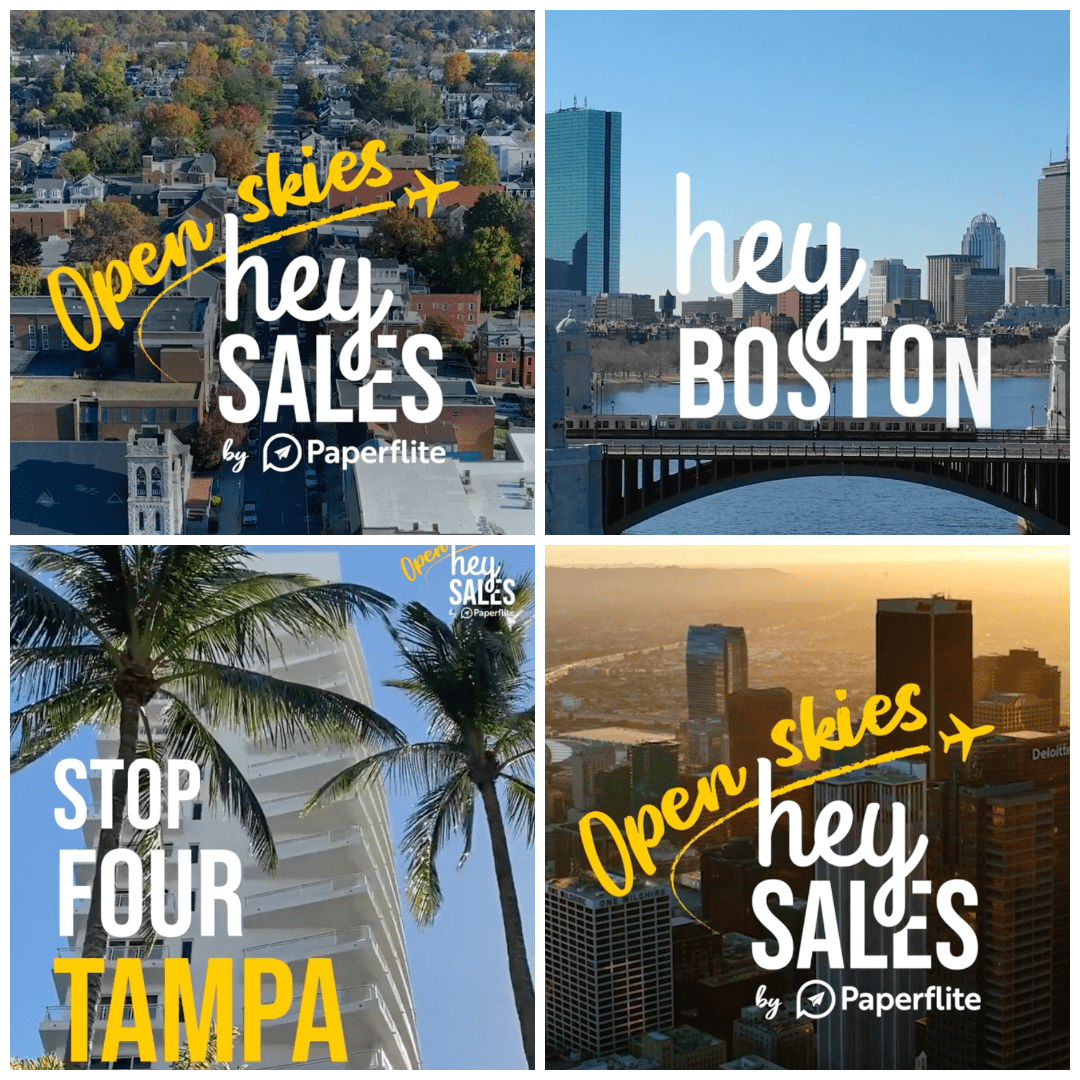
The HeySales Roadshow, orchestrated by Paperflite, was a dynamic B2B field marketing initiative that unfolded across multiple U.S. cities in 2024. This series of events was designed to engage sales professionals through interactive sessions, product demonstrations, and networking opportunities.
Key Highlights:
- Purpose: To provide sales teams with hands-on experience of HeySales' AI-powered platform, facilitating real-time, personalized coaching tailored to individual sales scenarios.heysales.ai
- Format: Each stop featured live demonstrations, workshops, and discussions led by industry experts, allowing attendees to explore the platform's capabilities in enhancing sales performance.
- Engagement: The roadshow fostered direct interactions between HeySales' team and sales professionals, enabling immediate feedback and personalized consultations.
The roadshow's success was evident in the enthusiastic participation and positive feedback from attendees, highlighting the value of immersive, in-person experiences in understanding and adopting innovative sales technologies.
Workday’s Executive Bus Tour
Launched in 2024, Workday’s 15-city Executive Bus Tour was designed to engage C-level enterprise decision-makers in a more personal and localized setting. The campaign ran alongside their national TV efforts but focused on creating meaningful face-to-face conversations around their enterprise cloud solutions—specifically targeting finance and HR leaders at large organizations.
By bringing Workday's brand directly to its audience—often at their own offices or nearby venues—the tour helped drive deeper product understanding, increased executive buy-in, and generated a 50% YoY spike in website visits within just a month of launch. It was a prime example of blending brand and demand in field marketing.
Accenture’s “Reinvented with Accenture” Campaign
Unveiled in April 2024, Reinvented with Accenture was a global brand campaign aimed at enterprise transformation leaders, including CIOs, CTOs, and innovation executives across industries. The goal was to spotlight real-world client stories that showcased how Accenture helps companies transform operations, culture, and customer experience.
The campaign spanned digital, TV, print, out-of-home, and partner channels in the U.S. and U.K. It was not just brand-building—it tied closely with content audits and optimization efforts, resulting in a 55% engagement boost and over $1.4 million in cost savings.
It reinforced Accenture’s positioning as both a strategic and execution partner in large-scale digital transformation.
Marketo
Hosts branded roadshows in London, Chicago, and Boston called Marketing Nation Roadshows and has an attractive agenda planned throughout the day. The company invites experts like Seth Godin to speak and provides opportunities for participants to network with their partners and community members.
SAP, Salesforce, and Oracle are famous for its landmark events that they host every year - Sapphire, Dreamforce, and OpenWorld. These events attract thousands of existing customers, partners, resellers, and prospects. Field marketers begin planning for these events at the beginning of the year and allocate separate budgets for it.
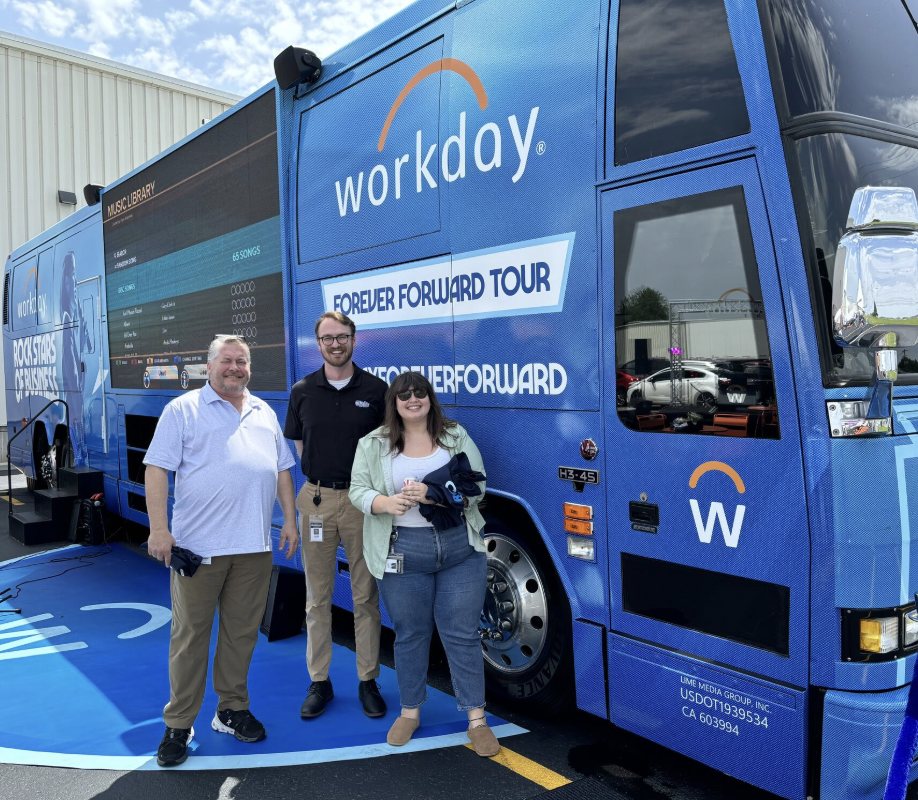
Building an End-to-End B2B Field Marketing Strategy
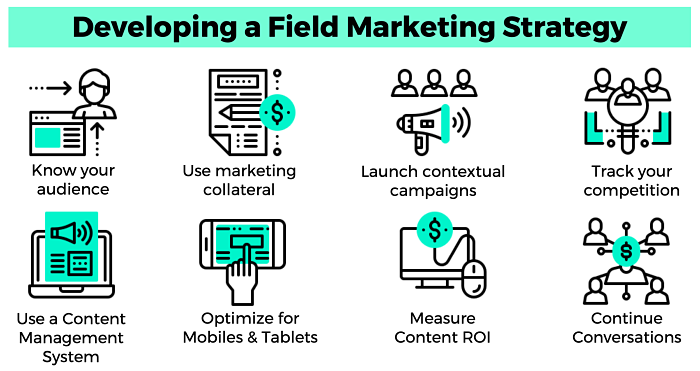
Modern field marketing isn’t just about showing up at events. It’s about delivering personalized, data-driven experiences at every touchpoint—before, during, and after the interaction. With the right setup, even small teams can run sophisticated field programs that drive real pipeline.
Here’s how to structure your strategy, with examples of how tools like Paperflite and Cleverstory can support each stage.
1. Define Your Audience and Map Buyer Needs
Start by understanding who you're targeting—enterprise buyers, regional partners, or mid-market decision-makers. Their roles, challenges, and priorities will shape your messaging, content format, and campaign design.
Digital platforms that track user behavior and profile-level interactions can help you segment buyers more intelligently and personalize outreach based on content consumption patterns.
2. Equip Field Teams with On-the-Go, Interactive Content
Reps in the field need more than static PDFs. They need flexible content formats that work across devices and environments.
Cleverstory’s Interactive pages or flipbooks—downloadable for offline use—can be especially effective.
These experiences can be created in advance or adapted quickly using templates. Reps can carry them on mobile devices or tablets, ready to present or send as follow-up.
And Paperflite’s Personalised content hubs or microsites are also valuable, especially when they include embedded assets that can track engagement.
3. Personalize Campaigns Based on Context
One-size-fits-all campaigns no longer cut through. Instead, build field campaigns around account size, industry, region, or funnel stage.
Cleverstory’s Smart gating mechanisms help tailor the flow of content based on user behavior—gating at the right moment based on your prospect’s content consumption and not upfront.
This balances lead capture with user experience and ensures that you're collecting intent-rich data, not just email addresses.
4. Capture Leads and Centralize Intelligence
Every interaction—whether a link click, gated download, or QR scan—should feed into a centralized lead system.
With Cleverstory you get provide with a detailed lead profiles, tracking not just who engaged, but how—what they clicked, downloaded, and re-engaged with.
This level of visibility allows for sharper qualification and quicker handoffs to sales.
Paperflite and Cleverstory’d seamless integration with CRM and marketing automation platform lets you to sync your lead data nto your CRM or marketing automation system, where email sequences and nurture campaigns can be triggered immediately.
5. Follow-Up with Targeted Nurture Sequences
Once leads are in the system, your follow-up needs to be tightly aligned with what they engaged with.
If someone viewed a product demo or downloaded a technical spec, your email sequence should reflect that interest. This is where integration with tools like HubSpot or Salesforce becomes essential—so that your outreach is both timely and relevant.
6. Track Performance and Optimize Continuously
Measurement is what separates great field marketing from guesswork. Make sure you’re capturing performance data across both engagement and conversion metrics.
Track content consumption—views, click paths, form fills—as well as broader campaign impact like lead quality and pipeline contribution. Having analytics that show which assets performed best, and which platforms delivered the highest ROI, helps you optimize campaigns in real time.
Use UTMs to attribute activity by channel—especially helpful when distributing links on social, email, or during events.
Tying It Together for Events and Roadshows
At in-person events, every moment should be an opportunity to capture interest and start a content journey. You can:
- Share digital experiences via QR codes or tablets
- Follow up with curated content collections personalized to each visitor
- Track what was viewed, shared, or downloaded post-event
- Sync this data into your CRM for seamless follow-up
How to measure your field marketing ROI?
1. Event Attendance vs. Registrations
- What: Compares the number of people who registered vs. who actually showed up.
- Why: Indicates event pull-through and targeting effectiveness.
- How: Track via event platforms, badge scans, or check-ins.
2. Lead Volume
- What: Total number of leads captured from field activities.
- Why: Core metric for demand gen alignment.
- How: Count leads from QR scans, forms, gated content, or event tools.
3. Lead Quality / MQL Conversion
- What: Percentage of captured leads that qualify as marketing-qualified (MQLs).
- Why: Quality trumps quantity—this shows relevance to ICP.
- How: Use lead scoring or CRM workflows based on firmographics, engagement, etc.
4. Pipeline Influence / Sourced Pipeline
- What: Amount of sales pipeline influenced or directly sourced by field campaigns.
- Why: Connects field efforts to revenue outcomes.
- How: Use multi-touch attribution in CRM or marketing automation platforms.
5. Meeting Bookings
- What: Number of sales meetings scheduled as a result of field activity.
- Why: A strong mid-funnel KPI—shows real buyer interest.
- How: Track via CRM, calendar integrations, or event follow-ups.
6. Cost per Lead (CPL)
- What: Total spend divided by number of leads generated.
- Why: Measures efficiency and budget impact.
- How: Include venue, logistics, staff, tech costs; divide by lead count.
7. ROI / Revenue Attribution
- What: Revenue generated or influenced divided by total field marketing spend.
- Why: The ultimate metric to justify field marketing investment.
- How: Use closed-won data tied to campaign attribution models.
8. Brand Engagement
- What: Metrics like booth visits, social mentions, content downloads, or QR scans.
- Why: Captures top-of-funnel brand impact even when leads aren’t generated.
- How: Use UTM tracking, social analytics, scan tools, or event platforms.
9. Feedback Score / NPS
- What: Post-event satisfaction ratings from attendees or sales.
- Why: Helps improve future campaigns and content relevance.
- How: Simple surveys or Net Promoter Score forms post-event.
B2B Field Marketing Job Description
Let us now describe a B2B field marketing role and what it entails. It includes:
- Work with marketers, sales managers, campaign managers, and product marketing managers to conduct and manage corporate events, campaigns, messaging, and communication programs.
- Align all programs with brand strategy, business objectives, and corporate campaigns to drive sales.
- Build and review the marketing plan with marketers and sales executives periodically and align it with corporate marketing to meet the company's goals and priorities.
- Partner with sales teams to understand revenue targets, monitor influenced sales pipeline, and provide quarterly campaign results and adapt as needed.
- Participate in monthly marketing calls and work with sales and marketing teams to achieve revenue targets.
- Ensure brand positioning and representation and communicate messages to prospects and customers effectively.
- Maintain complete transparency of all field marketing activities and campaigns by logging results in CRMs.
Field marketing is a part of the whole sales and marketing efforts, consistently contributing to brand building.
Selecting the Field Marketing Agency
Sometimes, B2C and B2B organizations prefer selecting a field marketing agency as against working with inhouse staff. It helps the company free up time for their marketers and sales reps to focus on their jobs instead of working on peripheral activities.
Here is a quick field marketing checklist that you can use prior to selecting an agency:
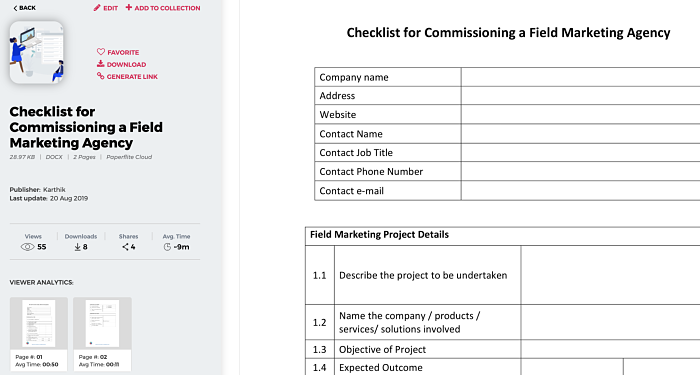
But, selecting and working with a field marketing agency is not a straightforward process. Here are ten questions that you need to ask yourself while working with a field marketing agency so you can get the best out of them:
- Does the field marketing agency know your business, products, solutions, target customers, and their personas well?
- Does the agency have credentials of helping customers like you in the past?
- Does the agency have an adequate geographic presence to match your requirements?
- Has the field marketing agency described the outcome, i.e., sales, profits, expenditures, and ROI?
- Are they charging you correctly for their services? Is it within your marketing budget?
- Have you briefed the objectives of the agency's appointment? (The better the brief, the more successful will be your campaign.)
- Will the field marketing agency tackle bring a bespoke and innovative approach to the marketing campaign? (Simply cobbling together template solutions from previous projects will not help).
- Are you comfortable sharing your business secrets to an external vendor?
- How frequently are you expected to review the progress of the campaign? (Fortnightly, Monthly, Quarterly.)
- In the event of an emergency, does the field marketing agency have adequate backup support?
What Does a Field Marketer Do?
A Day in the Life of a B2B Field Marketer
Field marketers are required to wear multiple hats, and as a result, they are adept at sales, marketing, customer onboarding, training, nurturing, and hosting events. They are closely involved with sales and marketing teams to help each other achieve common organizational goals.
Here's an example of a field marketer's daily routine:
7:00 am – Set out for a product demonstration meeting with prospects
My main task for the day is to host a breakfast meeting with prospects. Leave home to make it to 7:15 fast train. East Bloomington, here I come!
8:00 am – Gather my marketing collateral for the product demo
I arrive with 15 minutes in hand, so I have a last check over my briefing notes and refresh on the key points. I pull out my iPad and load up all the marketing collateral (including demos, brochures, case studies, and use cases). It helps me introduce familiar with our product and its features quickly.
10:15 am – Wrapped up the meeting
Nine of the ten prospects who had registered for the meeting have turned up, so it is a near full-house. They are happy to engage with our marketing collateral. The demo ends well, and they are excited to use our product right away. They have a lot of queries which shows they are keen to put it to use.
I am responsible for nurturing them through the 2-week trial prior and ensure they have a smooth experience. I make a quick note of reaching out to the prospects individually before the end of the day.
11.00 am – Attend the new product launch meeting at the office
Arrive at the office and greet our teams. We are three weeks away from launching a new nationwide product campaign. So, everybody from sales, marketing, media, communications, and advertising teams are in one room.
The product launch will be a big gathering of influencers, customers, brand loyalists - we have booked the Orange Country Convention Center for the event.
The meeting is productive as each team acknowledges its roles, and we have consensus on the expected outcome.
12:30 pm - Meeting with the sales reps
Meet with the sales reps who have been churning in good numbers. We discuss the recent prospects who need nurturing with contextual marketing collateral, and I take ownership of that.
We use a marketing collateral management system to exchange notes of which content is resonating with our target audience. The sales guys offer me lunch, which looks tempting, but I don't have time for that.
2:30 pm – Meet with partners and resellers
I am driving through Elliottsville to meet a mixed group of partners and resellers. This group needs training on our recently launched product features and key talking points.
They tell me that prospects have been dialing them up on a few queries about the product and they want to sort it out asap. Together, we explore our company's new marketing collateral that can be put to use for their conversations.
4:00 pm - Visit the venue booked for the new product launch
The partner meeting is done, which is a useful one. It is time to hitch a ride to the Orange Country Convention Center to meet the staff ahead of the event and finalize the stage, banners, danglers, kiosks, and break-out area.
6:00 pm - Head back to the office for an all-hands meeting
The meeting with the event staff goes well, and they have always delivered when it matters. Arrive back at the office 30 minutes before an all-hands staff meeting. I have just enough time to check email and catch up on the day's events.
Field Marketing: Conclusion
'Tell me, and I will hear, show me, and I will see, involve me and I will believe.' -- Confucius
Field marketing is everything that Confucius said thousands of years ago. It offers prospects and customers a chance to experience a product or a brand in unique ways that are not possible in a straightforward buyer-seller relationship.
On the other hand, it gives field marketers the ability to find out how prospects and customers might engage with the brand.
Together, it enables a one-on-one dialogue between the customer and brand ambassador while experiencing a product or a brand or a service.
